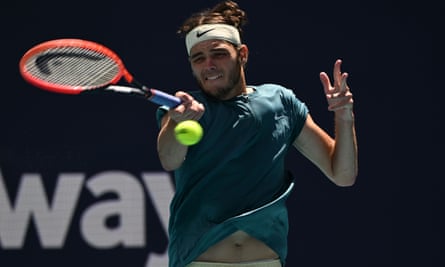Last week, shortly after Carlos Alcaraz and Jannik Sinner played the point of the year so far – exchanges of 80mph cross-court forehands; Sinner hooking the ball back from behind him; Alcaraz falling and recovering; the kind of exquisite drop shots and physics‑defying sliding we’ve come to expect from both; and, finally, a triumphant Sinner whipping up the crowd after a fruitless dive from Alcaraz left the Spaniard sprawled and breathless on Miami’s Hard Rock court – their colleagues took to social media in adoration and disbelief.
“Guys, are you from this planet?” and “What in the alien”, posted Aryna Sabalenka and Bianca Andreescu of the other-worldly efforts. “Absolute insanity” was the verdict of Jessica Pegula while John Isner wrote: “Tennis is in good hands.”
Sinner, who is 21, and Alcaraz, 19, are, along with Denmark’s Holger Rune, also 19, electrifying the ATP Tour in a way unseen since three certain other players. That Alcaraz is Spanish makes comparison with Rafael Nadal an easy one, and something that Juan Carlos Ferrero, Alcaraz’s coach, has described as unhelpful. But the youngster and the 14-times French Open winner do have history: they first met when Alcaraz was 13 and won a title on Nadal’s Junior Tour and they share a mental resilience.
Sinner, an Italian born close to the Austrian border, is calm personified; his maturity has earned comparisons to Roger Federer’s on-court demeanour, and he shares a love of fashion with the Swiss, collaborating with Gucci. At the Australian Open Sinner hit a down‑the-line forehand winner so similar to a famous Federer point that there is a side-by-side comparison on YouTube; although his style of play, including an incredible ability to turn defence into attack, is perhaps more Novak Djokovic in nature. Sinner, like Djokovic, is an accomplished skier with impeccable balance. Rune, meanwhile, is in the Djokovic mould as somewhat of a Marmite‑figure in temperament and occasional displays of arrogance. But the truth is that all three bring their own composite toolkits and flair to the court.
You might say the top of men’s tennis has skipped a generation. The cohort of players now in their mid-20s that was supposed to signal the changing of the guard, the passing of a torch, has not delivered as expected. Though Daniil Medvedev, Alexander Zverev and Stefanos Tsitsipas have come closest to fulfilling their potential, Andrey Rublev, Casper Ruud and Matteo Berrettini less so. The group has nowhere near troubled the supremacy of Nadal, Federer and Djokovic.
The Big Three have commanding head‑to-head leads over all the players who were supposed to usher them into retirement (with the exception of Federer against Zverev and Rublev, who have edged him by one match each). The only one of the ostensible successors to have won a grand slam title is Medvedev, who beat Djokovic in the 2021 US Open final (but still trails him five to nine in head-to-heads). Three of the above six are yet to win a Masters well into their careers.

Compare this with the early displays from Sinner, Alcaraz and Rune. Last year Rune became the youngest winner (19) of the Paris Masters since Boris Becker, downing Djokovic in the final. Alcaraz, the youngest year-end No 1, beat Nadal and Djokovic in successive days at the Madrid Open (which he went on to win); he has three Masters titles and a grand slam title. Sinner took the first two sets off Djokovic in an electrifying encounter at Wimbledon and he has appeared in two Masters finals and has the heaviest backhand on the tour by rotations-per-minute. He has saved more break points at his age than any of the Big Three had. All occupy spots in the top 10 and have edged ahead of players such as Felix Auger-Aliassime and Taylor Fritz in promise.
Fans are excited about the three prodigies not only because of their early success but for the nature of it. Sinner and Alcaraz’s meetings have the entertainment factor of Broadway shows, the thrill of rollercoasters. Alcaraz has said he “feels something different from the crowd” when the two play. Their epic five-hour US Open quarter-final was the best match of 2022. They have already played six times on the main tour, their head‑to-head evenly split, auguring a great rivalry of the future. Rune, too, is a big personality and a livewire to watch, whether it is tantrums on the court or beef with Stan Wawrinka and Casper Ruud. He is bringing a Kyrgiosesque, McEnroe-type chaotic energy that some claim is missing from the sport amid dwindling popularity. Their variety, too, is welcome; bringing drop shots and net play back after years of relentless baseline power-hitting.
Of course, in sport nothing is ever certain. Alcaraz’s frequent injuries are becoming a concern, the last example being hamstrung in the Rio Open final. Sinner has room to improve further his wonky ball-toss which can upset his serve. Rune, who has separated from Patrick Mouratoglou, must learn to keep his pugilism in check (in fairness he has already settled somewhat, thankfully not to the detriment of the spectacle). Many players who excel in their teens fade away; consistency and dedication are key.
The Big Three, however, have all declared this new trio the real thing – as has virtually everyone else. With Federer having already untied his bandana for the final time and Nadal expected to follow after the birth of his son and soon owing to a deteriorating foot condition, just Djokovic and a wonderfully resurgent Andy Murray of the modern giants will be around to stem the tide of the youngsters. Isner is right: tennis is in very good hands.




